comm
0.0(0)
0.0(0)
Card Sorting
1/104
There's no tags or description
Looks like no tags are added yet.
Study Analytics
Name | Mastery | Learn | Test | Matching | Spaced |
|---|
No study sessions yet.
105 Terms
1
New cards
* Maslow’s Hierarchy of Needs
\-social or belonging
\-have to go bottom to top
\-practical needs (use comm to get what we want)
\-have to go bottom to top
\-practical needs (use comm to get what we want)
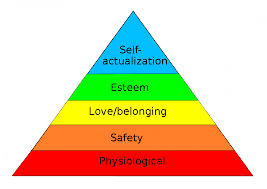
2
New cards
* Types of Noise
\-physical: channel-not much control over (external)
\-physiological: bio processses-ebb+flow, have control (internal)
\-psychological: most problematic, thoughts/unseen (internal)
\-semantic: 2 people applying different meanings to the same thing-more you know person less likely (internal)
\-physiological: bio processses-ebb+flow, have control (internal)
\-psychological: most problematic, thoughts/unseen (internal)
\-semantic: 2 people applying different meanings to the same thing-more you know person less likely (internal)
3
New cards
* Principles of Communication
\-unavoidable
\-symbolic
\-learned
\-involves ethics
\-unrepeatable (messages are repeatable, impact/effect isnt)
\-content (info) vs realtional (how commicated-tone/channel/duration, nonverbal, what else is being communicated)
\-(un)intentional
\-irreversible
\-symbolic
\-learned
\-involves ethics
\-unrepeatable (messages are repeatable, impact/effect isnt)
\-content (info) vs realtional (how commicated-tone/channel/duration, nonverbal, what else is being communicated)
\-(un)intentional
\-irreversible
4
New cards
* Self-monitoring
both effectiveness+approprieate
(achieve desired result, enhavnce relationship)
(achieve desired result, enhavnce relationship)
5
New cards
* Transactional Model Diagram
\-both send+recieve
\-simultaneous
\-environemnt (beliefs, values, etc), overalp:similariteis (all relationships start with none)
\-simultaneous
\-environemnt (beliefs, values, etc), overalp:similariteis (all relationships start with none)
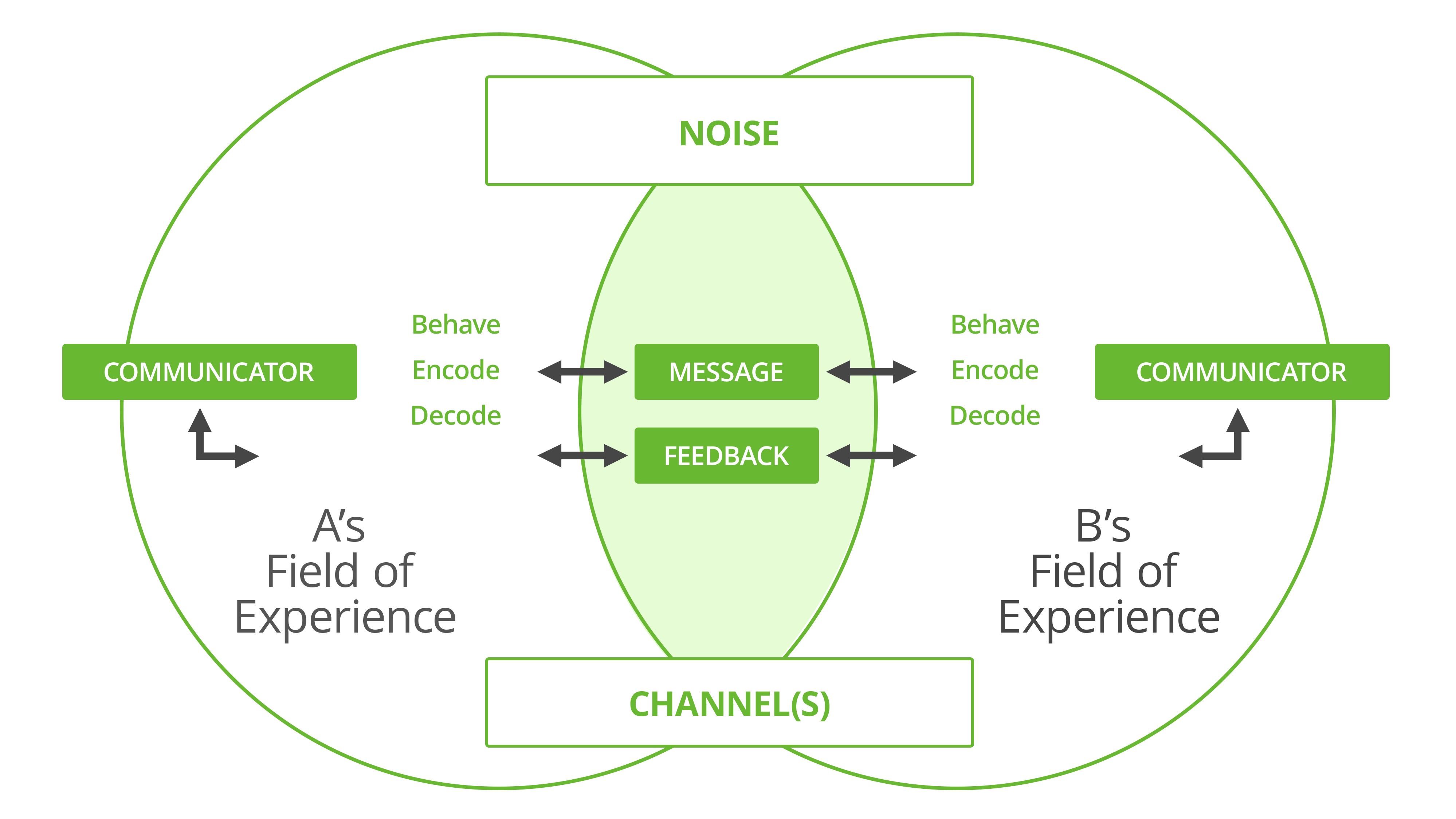
6
New cards
* Receiver(s)/Audience Size
7
New cards
* Masspersonal Communication
\-unseen
\-personal context
\-larger unseen audience
\-less mutual obligation
\-low expectation of privacy (bigger audience)
\-personal context
\-larger unseen audience
\-less mutual obligation
\-low expectation of privacy (bigger audience)
8
New cards
* A/Synchronous Communication
asynch→synch (real time)
\
\
9
New cards
* Disinhibition
10
New cards
* Nomophobia
fear/anxiety of being without phone
11
New cards
* Hyperpersonal
accelerated personal info sharing (relationship forms faster, vs in person, on sided relationship-so much at once)
12
New cards
* Message Richness
\
13
New cards
* Low/High Context
\-high: indirect, nonverbals, maintain social harmony
\-low: direct, specific, no reading between lines
\-low: direct, specific, no reading between lines
14
New cards
* Achieve/Nurturing
\-achievement: material, competitive-not enouhg to go around, voice opinions
\-nurturing: relationships, help others, keep opinions reserved
\-where is value placed?
\-nurturing: relationships, help others, keep opinions reserved
\-where is value placed?
15
New cards
* Power Distance
\-acceptance of unequal power distribution
\-low: minimal class distinction, democray, equal power distribution
\-high: one leader-people follower, older=power, repsect high status
\-low: minimal class distinction, democray, equal power distribution
\-high: one leader-people follower, older=power, repsect high status
16
New cards
* Ethnocentrism
viewing youre culture as superior, evaluating by youre culture standards=either way yours wins, precents growth
17
New cards
* Individualism/Collectivism
\-individualism: stand out, pride, private>public
\-collectivism: group preference, group involvement-more empathy, importance of duty
\-responsibility to self or others
\-collectivism: group preference, group involvement-more empathy, importance of duty
\-responsibility to self or others
18
New cards
* Co-culture
perception of membership that is part of a larger culture
19
New cards
* Social Identity
self concept based on group memberships
20
New cards
* Uncertainty Avoidance
\-defree of percieved threat (confusing-more confused=more avoidance-reflect group comm)
\-how to avoid
\-low: seek new interactions
\-high: avoids unuasal, desire for predictablility
\-how to avoid
\-low: seek new interactions
\-high: avoids unuasal, desire for predictablility
21
New cards
* Social Comparison
evaluating ourselves compared to others (in vs out groups)
22
New cards
* Identity Management
\-communiate sense of self with others
\-percieved self (private)
\-presenting self (public-socially approve want others to see)
\-face work (mask)
\-percieved self (private)
\-presenting self (public-socially approve want others to see)
\-face work (mask)
23
New cards
* Risks/Benefits of Self-Disclosure
\-benefits: catharsis, self clarification (does tis thought process of mine make sese to outisde), self validation, reciprocity, idenitty mangaemnt, relationships, moral obligation
\-risks: total rejection, negative impression, relational decrease, loss of influence, loss of control, hurt others
\-risks: total rejection, negative impression, relational decrease, loss of influence, loss of control, hurt others
24
New cards
* Alternatives to Self-Disclosure
\-silence (can give a chance for someone to voice thoughts)
\-lying (ommission-only disclosing certain)
\-equivocation (2+ equally possible meanings)
\-hinting (other person ability to connect)
\-evasion (disclosure would do more harm than good)
\-lying (ommission-only disclosing certain)
\-equivocation (2+ equally possible meanings)
\-hinting (other person ability to connect)
\-evasion (disclosure would do more harm than good)
25
New cards
* Social Penetration Theory
\-onion metaphore
\-breadth (not one dimmensional-varity)
\-depth (layers)
\-assumes you know everthing about youreself
\-self dsiclosed
\-if person leaves takes info with them-leaves gap, closes over time (rush right into relationship to fill-info dump)
\-LAYERS (out-middle): cliches, facts (verifiable), opinions, feelings
\-breadth (not one dimmensional-varity)
\-depth (layers)
\-assumes you know everthing about youreself
\-self dsiclosed
\-if person leaves takes info with them-leaves gap, closes over time (rush right into relationship to fill-info dump)
\-LAYERS (out-middle): cliches, facts (verifiable), opinions, feelings
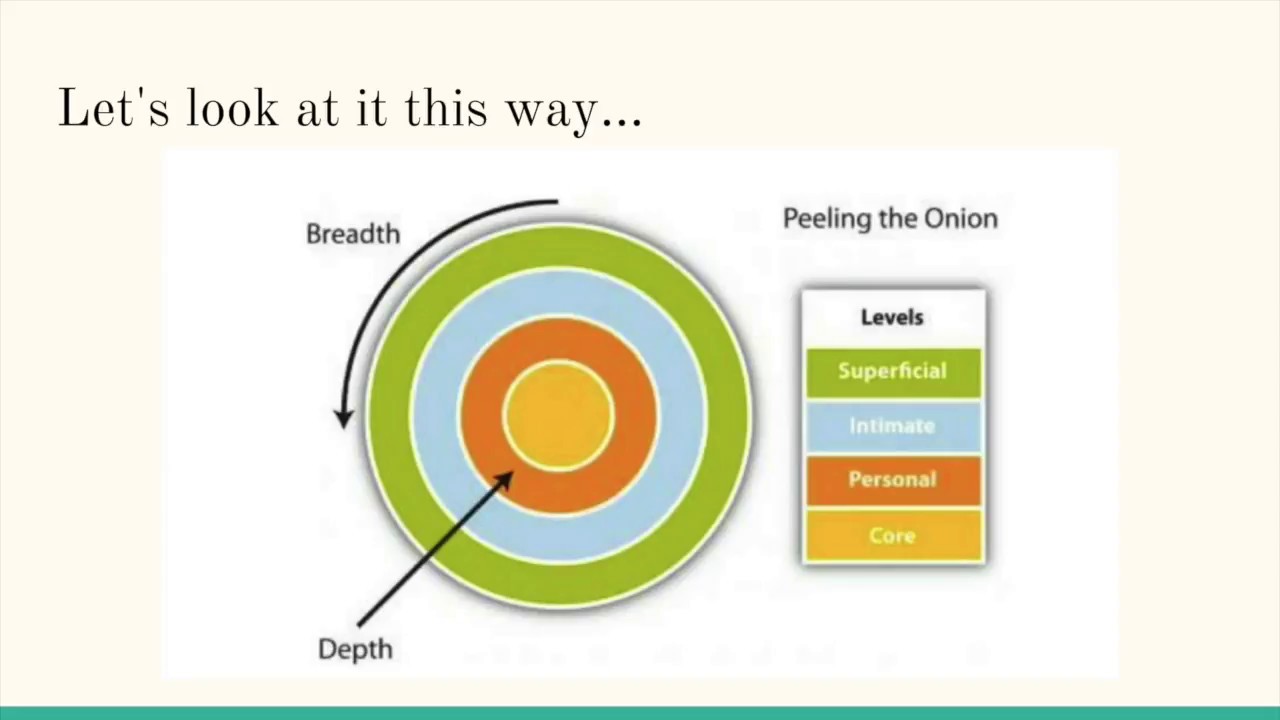
26
New cards
* Johari Window
\-who finds out
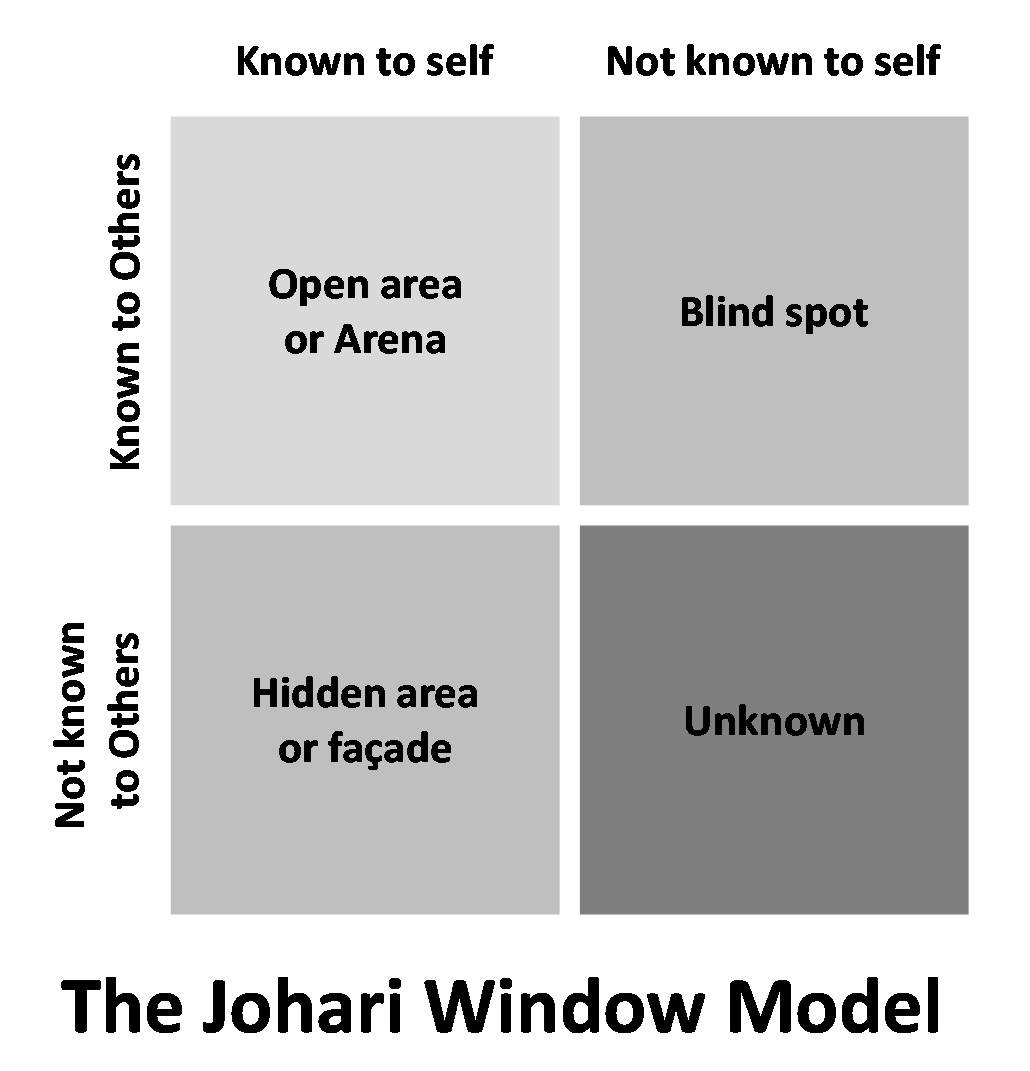
27
New cards
* Perceptual Schema
cognitive framework (physicalhole, interaction style, phsych stae/mood)
28
New cards
* Perception Process Steps
\-select inforation (usable vs not/not pay attention to)
\-organize (arrange data in meaning ful way to use in future)
\-interpret (relational satisfaction, personal experiences, personality, assumptions, online vs inperson)
(create first order, internal)
\-negotiation (external-between communicators, influence perception via comm, exchange of naratives/first order realities-only way we can look at world, (clashing narratives- dont look for common ground, personal bias) (shared naratives-if enough people, gives power))
\-organize (arrange data in meaning ful way to use in future)
\-interpret (relational satisfaction, personal experiences, personality, assumptions, online vs inperson)
(create first order, internal)
\-negotiation (external-between communicators, influence perception via comm, exchange of naratives/first order realities-only way we can look at world, (clashing narratives- dont look for common ground, personal bias) (shared naratives-if enough people, gives power))
29
New cards
* Self-serving Bias
30
New cards
* Physiological Influences (perceptions)
\-senses
\-age
\-health/fatigue
\-hunger
\-biological cycles
\-neurobehavioral challenges
\
\
\-age
\-health/fatigue
\-hunger
\-biological cycles
\-neurobehavioral challenges
\
\
31
New cards
* Perception Checking Process
\-describe behavior
\-two interpretations (can have more, not factual-possinilities)
\-ask for clarification (shows understading)
(characterists: cooperative, face saving)
\-two interpretations (can have more, not factual-possinilities)
\-ask for clarification (shows understading)
(characterists: cooperative, face saving)
32
New cards
Syntactic/Semantic rules \n
33
New cards
Subjective nature of language
34
New cards
Euphemisms \n
35
New cards
Relative Language \n
36
New cards
Abstraction \n
37
New cards
Static Evaluations \n
38
New cards
Evaluative/Emotive language
39
New cards
Ambiguous language \n
40
New cards
“It” Language
41
New cards
* Ambiguous
42
New cards
* Personal space
43
New cards
* Kinesics
44
New cards
* Paralanguage
\-tone, rate, pitch, pause
45
New cards
* Barrier Behavior
back up, object, turn,
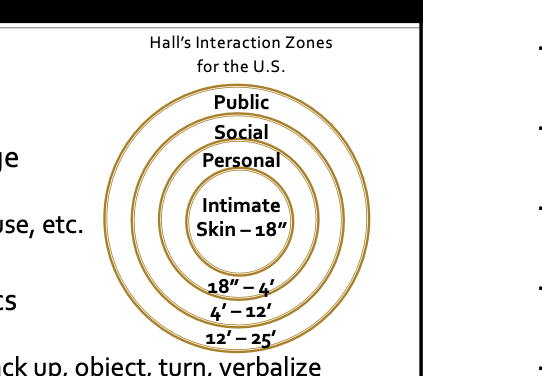
46
New cards
* Physical Environment
47
New cards
* Halls Interaction Zones Diagram
48
New cards
sender
origin of message
49
New cards
channel
send message through (connect send+recieve, not all equal, traded effectiveness ofr conviencenece)
50
New cards
context
environment message sent in (physical, cultural, social-emotional, historical)
51
New cards
interactional model
adds feed back (send to reciever+back through a channel)
52
New cards
why we communicate
\-physical needs
\-identity needs
\-social needs
\-practical needs
\-identity needs
\-social needs
\-practical needs
53
New cards
misconceptions of comm
\-always a good thing, seeks understading, more is better, solves problems, natural, common sense, always face to face
54
New cards
interpersonal communication
\-strategic (want something) process (concious vs unconsiuos, want to get back in) of message transation (co-create, overlap) between people to create+sustain shared meaning (extracting)
\-strategic efforst we make to better unstand+exchange
\-strategic efforst we make to better unstand+exchange
55
New cards
quanititavie
between 2 people, daily, impersonal
56
New cards
qualitative
treating as unique regardless of context/number involved (relies on how we treate each others, characterists)
57
New cards
commuication competence
\-effectiveness (large repertoir of skills, adaptablity)+appropriate (enhance hte realtionship-involvement, emphathy, cognitive complexity)--both: selfmonitoring, no ideal, must be able to adapt, situational, can be learned, characteristics
58
New cards
connection
relationship enhancement, supplement, ease in creation, sustain connection
59
New cards
alienation
replace online with inperson, health threats, substituting, vicious cycle
60
New cards
superficial
“friends”, echo chamber
61
New cards
meaningful
like minded, strength, stave off loneliness (certain extent)
62
New cards
healthy
connectedness (constant), social support, feedback
63
New cards
unhealthy
sleep deprication, depresion, self esteem
64
New cards
moderation is key
balance, underuse, active vs passive, known vs unknown
65
New cards
socail media
tech channels that make remote comm possible
66
New cards
mediated comm competence
\-types of channels (lack nonverbals/rich noncerbals) (asychronous/synched)
\-hyperpersonal comm
\-permanence
\-relational quality
\-repsect privacy boundaries
\-civil tone
\-communcators+environments
\-be mindful
\-balance mediate+in person
\-hyperpersonal comm
\-permanence
\-relational quality
\-repsect privacy boundaries
\-civil tone
\-communcators+environments
\-be mindful
\-balance mediate+in person
67
New cards
culture
shared personal+learned life experience of group individuals who have common set of values+norms+tradions
68
New cards
in group
groups we id with
69
New cards
out group
dont identify with
70
New cards
intercultural comm
different groups mements exchange+influence (salience-weight we attatch in intercultureal exchanges)
71
New cards
challanges of culture
\-sterotypes: fixed image, individual represents whole group
\-social categories (race, age)
\-social categories (race, age)
72
New cards
codes
\-language
\-verbal codes (direct, precision, formatility)
\-code-switching
\-microagressions
\-verbal codes (direct, precision, formatility)
\-code-switching
\-microagressions
73
New cards
competence (culture)
\-motivational+attitude
\-tolerance for ambignity/unknown
\-open-minded/culture respect
\-knowldge+skill
\-patience+perserverance
\-be prepared for consequences
\-relate to indivuals not cultures
\-tolerance for ambignity/unknown
\-open-minded/culture respect
\-knowldge+skill
\-patience+perserverance
\-be prepared for consequences
\-relate to indivuals not cultures
74
New cards
self-concept
relatively stable set of percaptions about self
75
New cards
self-esteem
evaluaitons of self worth, tied to self concept
76
New cards
developing self concept
\-created by refelcted apparaisals (mirror others around you)
\-significatn others (others who influence you)
\-michelangelo phenomenon
\-social comparisons (evaluating ourselves compared to others)
\-reference groups (people we use to evaluate our own characterists)
\-significatn others (others who influence you)
\-michelangelo phenomenon
\-social comparisons (evaluating ourselves compared to others)
\-reference groups (people we use to evaluate our own characterists)
77
New cards
why study interpersonal
\-new outlook
\-new meaning
\-time
\-improvemnet
\-new meaning
\-time
\-improvemnet
78
New cards
trends
stay with gorup (america low side: individualistic, low power distance+uncertainty avoidance, acheivemnet based)
79
New cards
characteristics of self concept
\-subjecitve (distortion-missing info/distorted feedbakc)
\-multifacetaed
\-resetant to change (in terms of positive info-cognitive conservation)
\-multifacetaed
\-resetant to change (in terms of positive info-cognitive conservation)
80
New cards
self fulfilling prophecies
\-expectations+subsequent behaviors make an evnt more likely to occure
\-expectation, align behaviior, event fruition, reinforce og expecgations
\-types: self imposed, imposed bu othres, communcaiton of expectaitions
\-expectation, align behaviior, event fruition, reinforce og expecgations
\-types: self imposed, imposed bu othres, communcaiton of expectaitions
81
New cards
self disclosure
\-purposely revealing info about self
\-honest, relevatory (cant guess, deeper/personal), availablity of infor (more people have acess=less), context of sharing
\-honest, relevatory (cant guess, deeper/personal), availablity of infor (more people have acess=less), context of sharing
82
New cards
SOCIAL PENETRATION THEORY
\-(very middle) feelings
\-opinions
\-facts (verifyable)
\-cliches
\
(gap-closes over time, leaves line-some deeper than others)
\-opinions
\-facts (verifyable)
\-cliches
\
(gap-closes over time, leaves line-some deeper than others)
83
New cards
guidelines for self disclosure
\-how important is other person
\-is risk reasonable
\-is self discloure appropriate
\-will effect be contrusctive
\
\-is risk reasonable
\-is self discloure appropriate
\-will effect be contrusctive
\
84
New cards
first order rality (perceptions)
physical-senses
85
New cards
2nd order reality
attach meaning to someones first order (judgements form)
86
New cards
social influesnce on perceptions
\-standpoint theory: posiiton in society shape your views
\-sex/gender roles
\-psych sex types
\-occupational roles
\-realtional roles
\-psych
\-culture+co-culutre
\-acess to info
\-sex/gender roles
\-psych sex types
\-occupational roles
\-realtional roles
\-psych
\-culture+co-culutre
\-acess to info
87
New cards
tendencies in perceptions
(-attach meaning (attribution))
\-snap judgemnts,
\- first impressions (halo/horns effect, primary/recency effect, confimraiton bias)
\-give ourselves bennetif of doubt
\-snap judgemnts,
\- first impressions (halo/horns effect, primary/recency effect, confimraiton bias)
\-give ourselves bennetif of doubt
88
New cards
empathy
recreating anothers persepective
\-emotional contagion: emoitons transferred from one person to another
\-value
\-ethios (civility, intervention, rehab)
\
requirements: openmind, imagnination, commitment
\-emotional contagion: emoitons transferred from one person to another
\-value
\-ethios (civility, intervention, rehab)
\
requirements: openmind, imagnination, commitment
89
New cards
language is symbolic
90
New cards
language is governed by grammar rules
\
\
91
New cards
language is subjective
\-triangle of meaning (word cat+brain=mental image of cat)
(meaning in people not htings)
(meaning in people not htings)
92
New cards
language+worldview
\-no english equivilent
93
New cards
convergence
match
94
New cards
divergence
emphasize differences
95
New cards
powerless
tentative, indirect, hesitations
96
New cards
powerful
direct, forecful, assertions
97
New cards
polite
save face (depends on social norms of culuter)
98
New cards
\-isms
stigmas, stop by subsituting nueutral terms
99
New cards
precision and vagueness
\
100
New cards
language of responsibliity